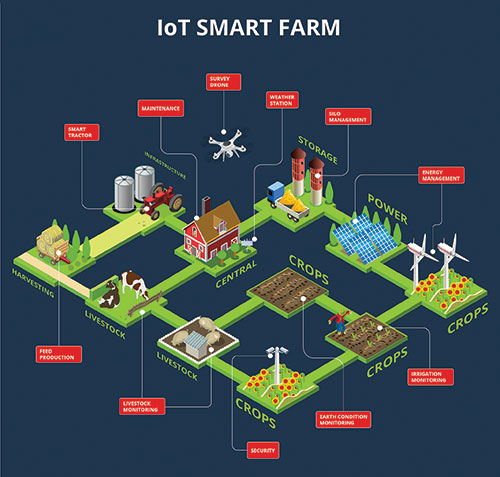The IoT can transform agriculture
Technews Industry Guide: Industrial Internet of Things 2017
IT in Manufacturing
Using IoT technologies can push the efficiency of farming to new levels as the food demands of a growing global population puts increasing pressure on agriculture around the world.
According to a report by Business Insider published at the end of last year, the world will need to produce 70% more food in 2050 than it did in 2006 in order to feed the earth’s growing population, based on numbers produced by the UN Food and Agriculture Organization.
André Strauss, director of partnerships at IoT.nxt, highlights five key areas where the use of IoT technology can improve efficiencies and reduce costs:
Digitisation of the value and supply chains allows for produce to be tracked and traced from source to retail shelf, delivering quality control and the ability to identify problem areas at production source.
By connecting all legacy machinery warehousing/packaging plants can be more productive and efficient. Farm managers can, for instance, assess how many packers, machines and delivery trucks will be required on any given day.
Energy management, a significant cost at large scale farming operations. Use of power, management of irrigation, pumps, dam levels, water required at production plants are all aspects of energy use that can be managed in real time and changed seamlessly for exceptional cost savings and improved efficiency.
Tracking of livestock which, amongst other things, will allow for management of health of livestock.
Management of fuel, another variable cost that has a direct impact on the cash flow of any farm. Using a digitised, connected management system allows for exact planning of fuel supply required for times of peak and reduced levels of activity.
BI Intelligence, Business Insider’s research service, predicts that IoT device installations in the agriculture world will increase from 30 million in 2015 to 75 million in 2020, for a compound annual growth rate of 20%.
According to the BI report the value of using IoT smart agriculture is evident in numbers available for the current leader of using IoT in farming, the United States, where 7 340 kg of cereal (e.g. wheat, rice, maize, barley, etc.) is produced per hectare of farmland, compared to the global average of 3 851 kg per hectare.
For more information contact Daleen van Wyk, IoT.nxt, +27 (0)83 302 0827, [email protected], www.iotnxt.com
Further reading:
Unlocking mining efficiency with advanced processing control
IT in Manufacturing
ABB’s Advanced Process Control system, powered by its Expert Optimizer platform, is emerging as a key enabler of smarter, more efficient mining operations.
Read more...
Open control technology reduces energy consumption and carbon footprint.
Beckhoff Automation
IT in Manufacturing
The Swedish company Airwatergreen AB is breaking new ground in the dehumidification of air in industrial buildings and warehouses. PC-based control from Beckhoff regulates the innovative process.
Read more...
Harnessing AI and satellite imagery to estimate water levels in dams
IT in Manufacturing
Farmers and water managers often struggle to accurately estimate and monitor the available water in dams. To address the challenge, International Water Management Institute researchers have worked with Digital Earth Africa to create an innovation that uses satellite images and AI to get timely and accurate dam volume measurements.
Read more...
Why industry should enter the world of operator training simulators
Schneider Electric South Africa
IT in Manufacturing
System-agnostic operator training simulator (OTS) software is a somewhat unsung hero of industry that trains plant operators in a virtual world that mirrors real-world operations. The benefits are multiple.
Read more...
Track busway for scalable data centre power delivery
IT in Manufacturing
The latest generation Legrand Data Centre Track Busway technology addresses the operational pressures facing today’s high-density, AI-intensive computing environments and is being well received by data centre facilities around the world.
Read more...
Poor heat management in data centre design
IT in Manufacturing
Designing a world-class data centre goes beyond simply keeping servers on during load shedding; it is about ensuring they run efficiently, reliably, and within the precise environmental conditions they were built and designed for.
Read more...
It’s time to fight AI with AI in the battle for cyber resilience
IT in Manufacturing
Cybercrime is evolving rapidly, and the nature of cyber threats has shifted dramatically. Attacks are now increasingly powered by AI, accelerating their speed, scale and sophistication. Cybersecurity needs to become part of business-critical strategy, powered by AI to match attackers’ speed with smarter, faster and more adaptive defences.
Read more...
Why AI sustainability must be a boardroom priority
IT in Manufacturing
As South African companies race to harness artificial intelligence for innovation and growth, few are asking the most critical question - the environmental cost.
Read more...
RS South Africa shines spotlight on MRO procurement
RS South Africa
IT in Manufacturing
RS South Africa has highlighted the growing pressures faced by procurement professionals responsible for maintenance, repair and operations supplies across the country’s vital economic sectors.
Read more...
Sustainable energy management
Siemens South Africa
IT in Manufacturing
Utilising its innovative ONE approach technology, Siemens provides complete transparency on resource consumption and offers data-driven optimisation recommendations for sustainable energy management.
Read more...


